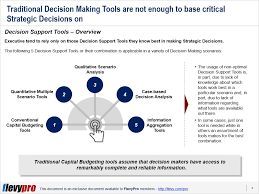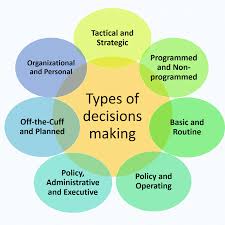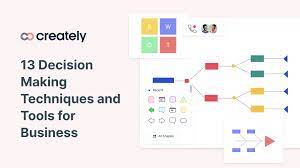Tools for Business Planning and Decision Making
In the fast-paced and ever-changing world of business, effective planning and decision making are crucial for success. Fortunately, there are numerous tools available that can help businesses navigate through complex challenges and make informed choices. These tools provide valuable insights, aid in strategic thinking, and enhance the decision-making process. In this article, we will explore some essential tools that can assist businesses in their planning and decision-making endeavors.
- SWOT Analysis: SWOT stands for Strengths, Weaknesses, Opportunities, and Threats. This tool helps businesses assess their internal strengths and weaknesses while identifying external opportunities and threats in the market. By conducting a SWOT analysis, businesses gain a comprehensive understanding of their competitive position, enabling them to capitalize on strengths, address weaknesses, seize opportunities, and mitigate threats.
- PESTEL Analysis: PESTEL stands for Political, Economic, Social, Technological, Environmental, and Legal factors. This tool helps businesses analyze the external environment by considering various factors that may impact their operations. Understanding these factors allows businesses to adapt to changes effectively and make informed decisions based on the prevailing circumstances.
- Decision Matrix: A decision matrix is a systematic approach to evaluate multiple options against specific criteria or parameters. It helps businesses compare different alternatives objectively by assigning weights to each criterion based on its importance. By using a decision matrix, businesses can rank options according to their suitability and make informed choices based on data-driven analysis.
- Scenario Planning: Scenario planning involves creating multiple plausible scenarios for the future based on different assumptions or variables. It helps businesses anticipate potential outcomes under various circumstances and develop strategies accordingly. By considering multiple scenarios in advance, businesses can be better prepared to respond quickly and effectively when unexpected events occur.
- Cost-Benefit Analysis: Cost-benefit analysis is a tool used to evaluate the financial feasibility of a particular project or decision by comparing its costs with its expected benefits. It helps businesses assess whether the potential benefits outweigh the costs and make rational choices based on economic considerations.
- Data Analytics: In today’s data-driven world, businesses have access to vast amounts of information. Data analytics tools allow businesses to analyze and interpret this data to gain valuable insights. By leveraging data analytics, businesses can identify trends, patterns, and correlations that can inform their planning and decision-making processes.
- Decision Support Systems (DSS): Decision support systems are computer-based tools that help businesses analyze complex problems and make decisions based on relevant data and models. DSS combines various techniques such as data analysis, simulation, optimization, and visualization to provide decision-makers with a comprehensive understanding of the situation at hand.
In conclusion, effective planning and decision making are essential for business success. The tools mentioned above provide valuable assistance in analyzing information, assessing options, and making informed choices. By utilizing these tools, businesses can enhance their strategic thinking capabilities and navigate through challenges with confidence. It is important for businesses to explore and adopt the right tools that align with their specific needs in order to improve their planning and decision-making processes.
Frequently Asked Questions: Tools for Business Planning and Decision Making
- What are business decision tools?
- What are the 7 decision-making tools?
- What is planning techniques and tools in business decision-making?
- What are common tools used for decisions making?
What are business decision tools?
Business decision tools are resources, techniques, or methodologies that assist organizations in making informed and effective decisions. These tools provide structure and guidance to the decision-making process, helping businesses analyze information, evaluate options, and choose the best course of action. Business decision tools can range from simple frameworks to complex software systems, each designed to address specific aspects of decision making. Some common types of business decision tools include:
- Decision Trees: Decision trees are graphical representations that help visualize and analyze different possible outcomes and choices. They use branches and nodes to map out various decision paths, probabilities, and potential consequences.
- Cost-Benefit Analysis: Cost-benefit analysis is a tool that compares the costs associated with a particular decision or project against the expected benefits it will generate. This analysis helps quantify both financial and non-financial factors to determine if the benefits outweigh the costs.
- SWOT Analysis: SWOT (Strengths, Weaknesses, Opportunities, Threats) analysis is a framework used to evaluate an organization’s internal strengths and weaknesses along with external opportunities and threats. It helps businesses identify key areas for improvement or potential risks to consider when making decisions.
- Financial Ratios: Financial ratios are mathematical calculations used to assess a company’s financial health and performance. These ratios can provide insights into liquidity, profitability, efficiency, and other key financial aspects that impact decision making.
- Decision Matrix: A decision matrix is a tool that allows businesses to objectively evaluate multiple options based on specific criteria or parameters. It assigns weights or scores to different factors to compare alternatives systematically and make data-driven decisions.
- Scenario Planning: Scenario planning involves creating multiple hypothetical scenarios based on different assumptions or variables. It helps organizations anticipate potential outcomes under various circumstances and develop strategies accordingly.
- Data Analytics: Data analytics tools enable businesses to analyze large datasets using statistical techniques and algorithms to uncover patterns, trends, correlations, and insights that can inform decision making.
- Decision Support Systems (DSS): Decision support systems are software applications that combine various tools and techniques to assist decision makers in complex problem-solving. DSS integrates data analysis, modeling, simulation, optimization, and visualization to provide comprehensive decision support.
These are just a few examples of the many business decision tools available. The choice of which tool to use depends on the specific nature of the decision, the available data, and the organization’s preferences and resources. Ultimately, these tools aim to improve the quality of decisions by providing structure, analysis, and evidence-based insights.
What are the 7 decision-making tools?
There are several decision-making tools that can be used to facilitate the decision-making process. Here are seven commonly used tools:
- Decision Matrix: A decision matrix is a structured approach to evaluate and compare different options against specific criteria or parameters. It involves assigning weights to each criterion based on their importance and assessing each option accordingly. This tool helps in objectively ranking alternatives and making informed decisions.
- SWOT Analysis: SWOT stands for Strengths, Weaknesses, Opportunities, and Threats. It is a tool used to analyze the internal strengths and weaknesses of a business or situation, as well as external opportunities and threats in the market. This analysis helps identify areas for improvement, capitalize on strengths, exploit opportunities, and mitigate threats.
- Pareto Analysis: The Pareto principle states that roughly 80% of effects come from 20% of causes. Pareto analysis helps identify the most significant factors contributing to a problem or outcome by focusing on the vital few rather than the trivial many. It enables businesses to prioritize their efforts and resources accordingly.
- Decision Trees: Decision trees are graphical representations that map out different possible decisions and their potential outcomes. They help visualize the consequences of different choices, including uncertainties or probabilities associated with each branch of the tree. Decision trees assist in analyzing complex decisions with multiple variables.
- Cost-Benefit Analysis: Cost-benefit analysis is a technique used to assess whether the benefits of a decision or project outweigh its costs. It involves quantifying both financial and non-financial factors associated with an option and comparing them to determine its overall value or feasibility.
- Fishbone Diagram (Ishikawa Diagram): A fishbone diagram is a visual tool that helps identify potential causes contributing to a specific problem or effect. It organizes various categories (such as people, processes, equipment, environment) as branches stemming from a central spine representing the problem itself. This tool aids in root cause analysis and finding solutions.
- Decision Support Systems (DSS): Decision support systems are computer-based tools that provide analytical capabilities and models to assist decision-makers. These systems integrate data analysis, simulations, optimization techniques, and visualization to provide insights and support complex decision-making processes.
These decision-making tools offer different approaches and perspectives to analyze information, evaluate options, and make informed decisions. The choice of tool depends on the specific context, complexity of the problem, available data, and the preferences of decision-makers.
What is planning techniques and tools in business decision-making?
Planning techniques and tools in business decision-making are approaches and resources that help organizations effectively strategize, set objectives, and make informed choices. These techniques and tools assist businesses in analyzing data, evaluating options, and creating actionable plans. Here are some commonly used planning techniques and tools:
- Goal Setting: This technique involves defining specific, measurable, achievable, relevant, and time-bound (SMART) goals. It provides businesses with a clear direction and helps align decision-making processes with desired outcomes.
- SWOT Analysis: SWOT analysis helps identify internal strengths and weaknesses of a business as well as external opportunities and threats in the market. By conducting this analysis, businesses can gain insights into their competitive position and make decisions accordingly.
- PESTEL Analysis: PESTEL analysis examines the political, economic, social, technological, environmental, and legal factors that may impact a business. It allows organizations to assess the external environment for potential opportunities or risks.
- Decision Trees: Decision trees are graphical representations of decisions and their potential outcomes. They help visualize different choices, their associated probabilities, costs, benefits, and potential consequences. This tool assists in evaluating various decision paths.
- Cost-Benefit Analysis: Cost-benefit analysis compares the costs of a decision or project against its expected benefits or returns. This technique helps assess whether the potential gains outweigh the expenses involved.
- Scenario Planning: Scenario planning involves creating multiple plausible future scenarios based on different assumptions or variables. It helps businesses anticipate potential outcomes under various circumstances to develop flexible strategies.
- Critical Path Method (CPM): CPM is a project management tool that identifies the most critical tasks required to complete a project within a specified timeframe. It helps allocate resources efficiently by identifying dependencies between tasks.
- Gantt Charts: Gantt charts visually represent project schedules by illustrating tasks along a timeline with their start dates, end dates, durations, dependencies, and progress tracking. They aid in planning and managing complex projects.
- Break-Even Analysis: Break-even analysis determines the point at which a business’s total revenue equals its total costs, resulting in neither profit nor loss. It helps assess the minimum level of sales required to cover costs.
- Data Analytics and Business Intelligence: Leveraging data analytics tools and business intelligence systems allows businesses to analyze vast amounts of data, identify patterns, trends, and correlations, and make data-driven decisions.
These planning techniques and tools provide businesses with structured approaches to decision making, enabling them to evaluate options objectively, mitigate risks, and optimize outcomes. Organizations can choose the most appropriate techniques based on their specific needs and circumstances to enhance their planning processes and achieve their strategic objectives.
What are common tools used for decisions making?
There are several common tools that are widely used for decision making across various industries and fields. Here are some of the most commonly employed tools:
- Decision Matrix: A decision matrix is a tool used to compare and evaluate multiple alternatives against specific criteria or parameters. It allows decision makers to assign weights to each criterion based on their importance and objectively assess the options.
- SWOT Analysis: SWOT (Strengths, Weaknesses, Opportunities, Threats) analysis is a tool used to assess an organization’s internal strengths and weaknesses while identifying external opportunities and threats. It helps in understanding the current position and making strategic decisions accordingly.
- Cost-Benefit Analysis: Cost-benefit analysis is a technique used to assess the economic feasibility of a project or decision by comparing its costs with its expected benefits. This tool helps in evaluating whether the benefits outweigh the costs and assists in rational decision making.
- Pareto Analysis: Pareto analysis, also known as the 80/20 rule, helps identify and prioritize the most significant factors contributing to a problem or outcome. It focuses on identifying the vital few factors that have the greatest impact so that resources can be allocated accordingly.
- Decision Trees: Decision trees are graphical representations that help in visualizing decisions, potential outcomes, and their probabilities. They assist in analyzing complex decisions by breaking them down into smaller branches, allowing decision makers to understand different paths and their associated risks.
- Mind Mapping: Mind mapping is a visual tool that helps organize thoughts, ideas, and information around a central concept or problem. It encourages brainstorming, enhances creativity, and aids in exploring different possibilities before making a decision.
- Six Thinking Hats: Developed by Edward de Bono, Six Thinking Hats is a technique where individuals explore different perspectives by wearing metaphorical “hats.” Each hat represents a specific thinking style (e.g., logical thinking, creative thinking) that helps in considering different angles and making well-rounded decisions.
- Decision Support Systems (DSS): Decision support systems are computer-based tools that assist decision makers in analyzing complex problems, evaluating alternatives, and providing data-driven insights. DSS combines various techniques such as data analysis, modeling, and simulation to aid in decision making.
These tools are just a few examples of the many available for decision making. The choice of tool depends on the specific needs, context, and nature of the decision at hand. Utilizing these tools can enhance the quality of decision making and lead to more effective outcomes.




